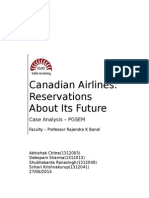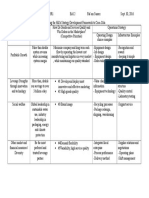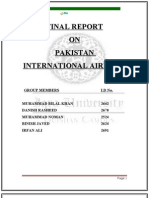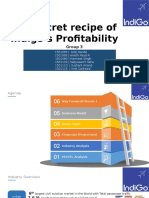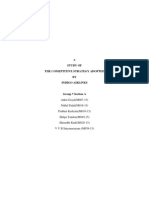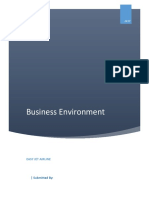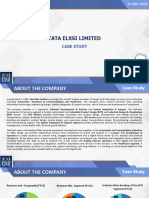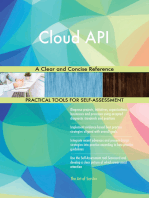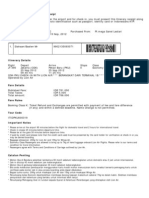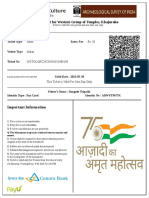Case Study On Continental Airlines
Uploaded by
Asad NabilCase Study On Continental Airlines
Uploaded by
Asad NabilContinental Airlines: One Companys Flight to
Success
INTRODUCTION
HISTORY AND PRESENT POSITION
Continental Airlines was a major U.S. airline, founded in 1934 and headquartered in Houston,
Texas. The company started its operation in the year 1934 as Varney Speed Lines with Lockheed
Vega, a single engine four-seated plane. On July 8, 1937 Varney Speed Lines was renamed as
Continental. Initially Continental Airlines was operating flights on EI Paso Denver route and
later on added many destinations.
Continental Airlines was the world's fifth largest airline. Continental, together with Continental
Express and Continental Connection, had more than 2,600 daily departures throughout the
Americas, Europe and Asia, serving 235 domestic and 138 international destinations. Continental
was a member of Star Alliance, which overall offers more than 21,200 daily flights to 1,172
airports in 181 countries through its 28 member airlines. With more than 40,000 employees,
Continental had hubs serving Los Angeles, Houston, Narita International Airport, and together
with its regional partners, carries approximately 138 million passengers per year. Its primary
hubs were at three airports, namely Cleveland Hopkins International Airport (Cleveland, Ohio),
Newark Liberty International Airport (Newark, New Jersey) and George Bush International
Airport (Houston, Texas).
Continental had ownership interests and brand partnerships with several carriers. Continental
was a minority owner of Express Jet Airlines, which operated under the 'Continental Express'
trade name but was a separately managed and public company. Chautauqua Airlines also flew
under the Continental Express identity, and Cape Air, Colgan Air, CommutAir, and Silver
Airways fed Continental's flights under the Continental Connection identity. Continental did not
have any ownership interests in these companies.
In May 2010, the airline announced that it would merge with UAL Corporation, the parent
company of United Airlines, via a stock swap. Continental's shares were acquired by UAL
1
Continental Airlines: One Companys Flight to
Success
Corporation. The acquisition was completed in October 2010, at which time the holding
company was renamed United Continental Holdings. During the integration period, each airline
ran a separate operation under the direction of a combined leadership team, based in Chicago,
Illinois. The integration was completed on 3rd March 2012, thereby creating the worlds largest
airline both in terms of flights offered and revenue generated. The announcement came on the
heels of Deltas 2008 merger with Midwest-based carrier Northwest Airlines. In an industry with
high volatility, heavy capital investments, and extremely price sensitive customers, mergers as a
way to improve costs and maximize revenue is certainly not surprising.
PRODUCT& SERVICES
United Continental Holdings unites cities around the globe through subsidiaries United Air
Lines and Continental, titans among passenger and cargo air carriers. While United Air Lines and
Continental are its main lines, the company also has regional operations, which are operated
under contract by United Express, Continental Express, and Continental Connection. Combined,
the company handles an average of 5,166 flights a day to more than 374 domestic and
international destinations from hubs that include Chicago, Houston, Los Angeles, New York, San
Francisco, and Washington, DC. The company also sells fuel, as well as offers catering, ground
handling, and maintenance services for third parties. As of 2014, it operated through a fleet of
approximately 700 mainline aircraft.
Worlds Most Comprehensive Route Network
373 Destinations (airports served)
235 Domestic destinations (airports served)
138 International destinations (airports served)
60 Countries Served
4,935 Daily Departures
2
Continental Airlines: One Companys Flight to
Success
138 Million Passengers in 2014
Member Lounges
More than 45 United Clubs in 38 airports worldwide offer members complimentary bar service,
light snacks and beverages; business amenities such as Wi-Fi, conference rooms and
workstations; and personalized assistance with reservations, seat selection, upgrades and
boarding passes.
MARKET SHARE
As of September 31, 2014, United Continental Holdings has a 15.40 % market share based on
Revenue Passenger Miles.
Continental Airlines: One Companys Flight to
Success
COMPITITORS
United competes primarily with large carriers like American Airlines (AAL) and Delta Air Lines
Inc. (DAL) but also competes with low-cost carriers like Southwest Airlines Company (LUV),
both domestically and internationally. Because of high fuel and other operating expenses, United
has the highest Cost per Available Seat Mile in the airline industry, 13.5 cents. To combat its
increasing operating expenses, United has implemented several strategies prevalent throughout
the airline industry including cutting food and beverage services and charging customers extra
fees to check in baggage.
HUMAN RESOURCES
As of December 31, 2013, UAL, including its subsidiaries, had approximately 87,000
employees. Approximately 80% of the Companys employees were represented by various U.S.
labor organizations as of December 31, 2014.
Continental Airlines: One Companys Flight to
Success
Collective bargaining agreements between the Company and its represented employee groups are
negotiated under the RLA. Such agreements typically do not contain an expiration date and
instead specify an amendable date, upon which the contract is considered open for amendment.
The Company continues to integrate its remaining employee groups in connection with the
Merger, such process being governed by a combination of the RLA, the McCaskill-Bond
Amendment, and where applicable, the existing provisions of Uniteds collective bargaining
agreements and union policies.
OBJECTIVE OF THE REPORT
1. If you are placed to manage in an organization facing stress, what steps can you take in
order to bring the company back on track?
2. Specify the reasons behind the changes of morale among the employees of continental
airlines.
THEORITICAL AND PRACTICLE ISSUES OF THE CASE
5
Continental Airlines: One Companys Flight to
Success
Question no:1
If you were the manager of a distressed organization, what specific steps would you take to
turn the organization around?
If we were the manager then we will take some steps to improve the present situation. Those
steps are given below to turn around my organization.
Reduce Employee Dismissal:
Our first step is to reduce employee dismissal by providing motivation, such as on time wages
and salary pay, We will train unskilled people but we will not layoff them. Before dismissal
employment we will give them time to prove their skill. In this case we found that on the crisis
moment of the Continental Airlines they had undergone several series of layoff but on that
moment they should to move them to other airline companies or by reducing their payment and
kept them. Otherwise they could help them to take different types of professional training for
building career to other sector or another airline company. On the case we found that the new
CEO and the old CEO had dismissed the employees without any notice and any benefits which is
inhumanity. In the long run the continental airline will be suffering lots because the talented
employees dont like this type of organization and continental cant hire the talented people in
future. When need to fire the employees we will try to keep in mind above things.
Employees Benefits:
We will try to give the incentives to the worker in two ways, thats psychologically and
physically, it can be given the recognition of the best performer in front of whole employees. Its
not true that only money can motivate the employees. We will give the best performer award in
quarterly basis. We will try to give the benefits to employees.
Training and Development:
We will provide various types of professional training to the employee. Every training program
will have a targeted point which will help to my employees to solving the various types of
problem. We will take skill oriented employee development process which will help to
succession planning.
6
Continental Airlines: One Companys Flight to
Success
Performance Appraisal and Rewards:
We will review and monitor their performance regularly. After assessing the performance we will
provide rewards to the performer. We will give them recognition within the organization so they
will be motivated physiologically. On the case the new CEO also changed the performance
appraisal system but we will flow the above things about performance appraisal and it will be
help full more.
Participative Management:
When we will take any major decision within the organization then we will take opinion from
different respective level of mangers an employee. When we will take strategic decision then we
will take top-level and mid-level employees. When we will make operation level decisions then
we give priority to operation level employees. People get engaged fleeing within the
organization. They will start to thinking as an undividable part of organization. The new CEO
comes out to solve the problem and he made success because he ensured that all people can give
their valuable advice to make any big decision.
Working authority:
When we will give the working authority to the employees then their productivity will be
increased. They will perform their job with own authority. In the case we found that the new
CEO had given the employees autonomy.
Question no: 2
Continental Airlines: One Companys Flight to
Success
What are the primary causes for the sudden change in employee morale at Continental
Airlines?
Connection
Employees need to feel there is a connection between themselves and management. That they
share a common purpose and common goals. They need to know that management knows worthy
are, what is going on with their job and that management is there to help them when needed.
One-way to connect with employees is to spend time with them. We should regularly work along
with them if possible. If not then take some time and find a reason to sit with them at their desk.
Perhaps to check something they are working on or just to stop in and see how they are doing.
Recognition
Employees want recognition and acknowledgment that their work has purpose and that it is
appreciated. Never miss an opportunity to recognize when someone has done good work. Even a
simple Thank You when an employee completes a task for you will help them see their work is
appreciated. If employees have worked hard on something and done a good job, they almost
expect to be recognized for it. It affirms that their work is appreciated and that you respect the
work that they do. Awards and public recognition of work above and beyond are excellent ways
to recognize the hard work of your employees. All employees want recognition from
management and their peers. A manager may also benefit from the increased performance of
others so they also can get an award.
Effective Teams
Team building is a more complex challenge than fostering high morale in individual employees.
Here are five problems that many teams develop that keep them from being as effective as they
want to be in accomplishing company goals:
Absence of Trustdue to invulnerability
Fear of Conflictartificial harmony
Lack of Commitmentambiguity
Continental Airlines: One Companys Flight to
Success
Avoidance of Accountabilitylow standards
Inattention to Resultscaused by individual status and ego issues
In the absence of trust, morale is at its lowest and self-protectionism becomes the rule. It doesnt
take a PhD in psychology to realize that this will limit productivity and make work a lot less
rewarding for both employees and their managers. This every man for themselves attitude
destroys teams and makes it impossible to optimize goal setting and achieve corporate objectives
in a timely manner, if at all. By learning to communicate more effectively based on honesty,
consistency, vulnerability, and respect, your teams will be able to focus unselfishly on common
results. This in turn keeps individual egos and agendas in check.
Sharing New Ideas:
Once youve built trusting relationships and developed a foundation of respect, employees will
automatically respond with more new ideas. The best way to nurture and benefit from their newfound ideas is to go by the philosophy that there are no bad ideas, only undeveloped ones.
Trusted and respected employees with managers who reinforce the fact that they have some
flexibility to try new things will surprise you with the new ideas ingenuity that they bring to their
work. The best part is that you get this for the same price youre paying unhappy employees
who are doing just enough to get by.
Based on case:
One of the first things that Bethune recognized needed change at Continental was employee
morale. This would be no easy task as many workers at the airline felt completely detached from
the organization, which was due in large part to the previous management team. Lorenzo, the
former chief executive, was cut off from employees and did not communicate. Bethune
immediately created change by establishing an open door policy and encouraging employees to
participation with management. One mechanism employed to build participation is a toll-free
hotline to handle employees suggestions, which is managed by a cross-section of the employeebase. He wanted to establish a new corporate culture where employers and employees will work
together. As a result he involved his workers in the decision making processes at Continental.
Continental Airlines: One Companys Flight to
Success
Bethune was ready to listen actively to worker concerns. Therefore, he invited workers to call his
voice mail, and when they called, he called them back. When he personally returned calls and
employees started to realize that the management team was really listening to their suggestions.
These important steps helped Bethune to gain the trust of employees and by extension, care
about their work.
To boost up employee morale, Gordon changed performance appraisal practices. The focus of the
performance appraisals shifted toward achievement and facilitation of on-time flights. To
emphasize the importance of this goal, management devised an incentive system that promised to
reward each employee $100 if they achieved the number 1 ranking in the Department of
transportations. Moreover, to acknowledge perfect attendance by employees, seven workers
were rewarded new sport utility vehicles at the companys expense.
To sum up it can be said that, by focusing on the workers and rewarding them for displaying the
behaviors and actions necessary to the companys success, Gordan Bethune was able to change
in morale at Continental Airlines.
CONCLUSION
Only ten years ago, Continental was in trouble. There were ten major US airlines, and
Continental ranked tenth in on-time performance, mishandled baggage, customer complaints,
and denied boardings because of overbooking. Not surprisingly, with this kind of service,
Continental was in financial trouble. It had filed for Chapter 11 bankruptcy protection twice in
the previous ten years and was heading for a third, and likely final, bankruptcy. It had also gone
through ten CEOs in ten years. People joked that Continental was a Per- fect 10.
The rebirth of Continental began in 1994 when Gordon Bethune took the controls as CEO. He
and Greg Brenneman, who was a Continental consultant at the time, conceived and sold to the
Board of Directors the Go Forward Plan. It had four interrelated parts that had to be executed
simultaneously.
United Continental Holdings, Inc. The Company became the parent company of Continental
Airlines, Inc. ("Continental") upon the closing of a merger transaction (the "Merger") on October
10
Continental Airlines: One Companys Flight to
Success
1, 2010. As part of the Merger integration, on March 31, 2013, the Company merged its two
operating subsidiaries, Continental and United Air Lines, Inc. ("United Air Lines"), with
Continental continuing as the surviving corporation and as a wholly owned subsidiary of the
Company. Upon the closing of this transaction on March 31, 2013, Continental's name was
changed to "United Airlines, Inc.
RECOMMENDATION
The greatest challenge United is facing is a lack of leadership and credibility both
internally and externally. The company needs new leadership and a new strategy.
Some of the integration process work still remains unfinished. So they should finish
remaining works.
United's mechanics still are working under separate contracts and IT systems. The
company should migrate to a single IT system on a fleet-by-fleet basis.
United still flies many smaller regional jets, which guzzle fuel and whose close quarters
and slower speeds annoy passengers. They should replace these jets.
The carrier also operates too many hubs, which adds expense. In order to minimize costs
its hubs should be reduced.
Their customer service is not good so their customer service should be developed.
The company should provide adequate training to the employees.
Enhance/Expand transcontinental routes.
Strengthen alliances for customer convenience.
REFERANCES
11
Continental Airlines: One Companys Flight to
Success
Analoui, F. (2000). What motivates senior managers?: The case of Romania, Journal of
Managerial Psychology, 15(4), 324-340.
Carey, Susan, (2014). United Continental: One Sick BirdRetrieved from
http://loyaltylobby.com/2014/06/09/wsj-united-continental-one-sick-bird/
Chambers, R. (1996). GPs low morale is contributing factor. British Medical Journal, 313, 302.
Cox, K. B. (2001). The effects of unit morale and interpersonal relations on conflict in the
nursing unit. Journal of Advanced Nursing, 35(1), 17-25.
Dye, F, C. & Garman, N. A. (2006). Exceptional Leadership: 16 Critical Competencies For
Healthcare Executives. Chicago: Health Administration Press.
Greenleaf, R.K. (1996). On becoming a servant-leader. San Francisco, CA: Josey-Bass
Publishers.
McKnight, D. H., Ahmad, S. and Schroeder, R. G. (2001). When do feedback, incentive control
and autonomy improve morale? The importance of employee-management relationship
closeness. Journal of managerial Issues, 13(4), 466-482.
Psychometrics Canada (2010). Feuding and failure vs. Performance and innovation. Retrieved
from http://www.psychometrics.com/docs/leadership.pdf
Rauktis, M. E. &Koeske, G. F. (1994). Maintaining social worker morale: When supportive
supervision is not enough. Administration in Social Work, 18(1), 39- 60.
Straka, J. W. (1993). Is poor worker morale costly to firms? Industrial and Labor Relations
Review, 46(2), 381-394.
(2014, 11). Major Competitors. Retrieved from
http://finance.yahoo.com/q?s=UAL
12
You might also like
- DNP3 User Guide Axon Test - 20150728AT38UG0ENo ratings yetDNP3 User Guide Axon Test - 20150728AT38UG0E61 pages
- Virgin Atlantic Marketing Case Study: Brand Management AssignmentNo ratings yetVirgin Atlantic Marketing Case Study: Brand Management Assignment22 pages
- How Can Capacity and Utilization Be Measured at Airline Such As SWANo ratings yetHow Can Capacity and Utilization Be Measured at Airline Such As SWA2 pages
- The Comprehensive Study of Economics and Future Scope of Electric VehiclesNo ratings yetThe Comprehensive Study of Economics and Future Scope of Electric Vehicles4 pages
- Indian Aviation Sector Political Factors: PESTEL AnalysisNo ratings yetIndian Aviation Sector Political Factors: PESTEL Analysis3 pages
- Dell's Corporate Social Responsibility RecommendationsNo ratings yetDell's Corporate Social Responsibility Recommendations26 pages
- Allergan Case Analysis: This Study Resource WasNo ratings yetAllergan Case Analysis: This Study Resource Was5 pages
- APEX Unit 3 Human Resource Management-2No ratings yetAPEX Unit 3 Human Resource Management-210 pages
- Service Marketing - Singapore Airline - Group 6No ratings yetService Marketing - Singapore Airline - Group 67 pages
- Oracle Airline Data Model: Key Features and BenefitsNo ratings yetOracle Airline Data Model: Key Features and Benefits2 pages
- C C C CC C: Case Study Strategic Management Evaluation IINo ratings yetC C C CC C: Case Study Strategic Management Evaluation II8 pages
- Business Process Re-Engineering at ONGCNo ratings yetBusiness Process Re-Engineering at ONGC20 pages
- Seven Cost Saving Tips For Disaster RecoveryNo ratings yetSeven Cost Saving Tips For Disaster Recovery11 pages
- Strategic Planning of Emirates Airline Commerce EssayNo ratings yetStrategic Planning of Emirates Airline Commerce Essay3 pages
- Saurav Das - 046 - Eprocurement at Cathay Pacific AirwaysNo ratings yetSaurav Das - 046 - Eprocurement at Cathay Pacific Airways5 pages
- Electronic Data Interchange (EDI) : Rebecca Fouts Laura Frye Laura Gray Matt Muller Ariana PelayoNo ratings yetElectronic Data Interchange (EDI) : Rebecca Fouts Laura Frye Laura Gray Matt Muller Ariana Pelayo31 pages
- Low Cost Airlines PROJECT: RYANAIR V/S AIRBERLINNo ratings yetLow Cost Airlines PROJECT: RYANAIR V/S AIRBERLIN13 pages
- What Is Cost of Equity of TATA POWER Company Limited?No ratings yetWhat Is Cost of Equity of TATA POWER Company Limited?6 pages
- The Secret Recipe of Indigo's Profitability: Group 3No ratings yetThe Secret Recipe of Indigo's Profitability: Group 313 pages
- Knipss Engineering Institute Department of Cse: Project OnNo ratings yetKnipss Engineering Institute Department of Cse: Project On32 pages
- Case Study: ERP Implementation at A Steel Manufacturing CompanyNo ratings yetCase Study: ERP Implementation at A Steel Manufacturing Company3 pages
- ACI Certificate in Airport Business Operations Course PNo ratings yetACI Certificate in Airport Business Operations Course P1 page
- Methodology For Digital Transformation Implementation Path and Data Platform 981No ratings yetMethodology For Digital Transformation Implementation Path and Data Platform 981341 pages
- Performance Management at NIM - Case Analysis50% (2)Performance Management at NIM - Case Analysis10 pages
- Intelligent Transportation System: revolutionizing mobility with robotics and automationFrom EverandIntelligent Transportation System: revolutionizing mobility with robotics and automationNo ratings yet
- Managing in a Service-Focused World: I, team, stewards and marketplaceFrom EverandManaging in a Service-Focused World: I, team, stewards and marketplaceNo ratings yet
- FADILLAH MUHAMMAD DAVIN Emgs Approva Letter ME701136640No ratings yetFADILLAH MUHAMMAD DAVIN Emgs Approva Letter ME7011366401 page
- Shripal Mepani - 4 - INDB - MMCT - 8125340883No ratings yetShripal Mepani - 4 - INDB - MMCT - 81253408831 page
- User Guide Winter 2023 Course Registration Consent FormNo ratings yetUser Guide Winter 2023 Course Registration Consent Form6 pages
- Registration Form - All Sindh Youth Spelling Bee Competition (2024-25)No ratings yetRegistration Form - All Sindh Youth Spelling Bee Competition (2024-25)2 pages
- WWVP Identity Requirements - Access CanberraNo ratings yetWWVP Identity Requirements - Access Canberra2 pages
- Virgin Atlantic Marketing Case Study: Brand Management AssignmentVirgin Atlantic Marketing Case Study: Brand Management Assignment
- Organizational Readiness to E-TransformationFrom EverandOrganizational Readiness to E-Transformation
- How Can Capacity and Utilization Be Measured at Airline Such As SWAHow Can Capacity and Utilization Be Measured at Airline Such As SWA
- The Comprehensive Study of Economics and Future Scope of Electric VehiclesThe Comprehensive Study of Economics and Future Scope of Electric Vehicles
- Indian Aviation Sector Political Factors: PESTEL AnalysisIndian Aviation Sector Political Factors: PESTEL Analysis
- Dell's Corporate Social Responsibility RecommendationsDell's Corporate Social Responsibility Recommendations
- Oracle Airline Data Model: Key Features and BenefitsOracle Airline Data Model: Key Features and Benefits
- C C C CC C: Case Study Strategic Management Evaluation IIC C C CC C: Case Study Strategic Management Evaluation II
- Strategic Planning of Emirates Airline Commerce EssayStrategic Planning of Emirates Airline Commerce Essay
- Saurav Das - 046 - Eprocurement at Cathay Pacific AirwaysSaurav Das - 046 - Eprocurement at Cathay Pacific Airways
- Electronic Data Interchange (EDI) : Rebecca Fouts Laura Frye Laura Gray Matt Muller Ariana PelayoElectronic Data Interchange (EDI) : Rebecca Fouts Laura Frye Laura Gray Matt Muller Ariana Pelayo
- What Is Cost of Equity of TATA POWER Company Limited?What Is Cost of Equity of TATA POWER Company Limited?
- The Secret Recipe of Indigo's Profitability: Group 3The Secret Recipe of Indigo's Profitability: Group 3
- Knipss Engineering Institute Department of Cse: Project OnKnipss Engineering Institute Department of Cse: Project On
- Case Study: ERP Implementation at A Steel Manufacturing CompanyCase Study: ERP Implementation at A Steel Manufacturing Company
- ACI Certificate in Airport Business Operations Course PACI Certificate in Airport Business Operations Course P
- Methodology For Digital Transformation Implementation Path and Data Platform 981Methodology For Digital Transformation Implementation Path and Data Platform 981
- Intelligent Transportation System: revolutionizing mobility with robotics and automationFrom EverandIntelligent Transportation System: revolutionizing mobility with robotics and automation
- Production planning A Clear and Concise ReferenceFrom EverandProduction planning A Clear and Concise Reference
- Managing in a Service-Focused World: I, team, stewards and marketplaceFrom EverandManaging in a Service-Focused World: I, team, stewards and marketplace
- FADILLAH MUHAMMAD DAVIN Emgs Approva Letter ME701136640FADILLAH MUHAMMAD DAVIN Emgs Approva Letter ME701136640
- User Guide Winter 2023 Course Registration Consent FormUser Guide Winter 2023 Course Registration Consent Form
- Registration Form - All Sindh Youth Spelling Bee Competition (2024-25)Registration Form - All Sindh Youth Spelling Bee Competition (2024-25)
